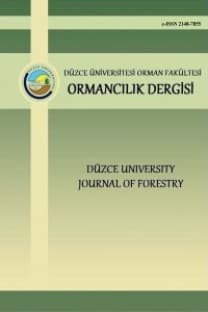Boylu Maviyemiş (Vaccinium corymbosum L. )’in Çelikle Üretilmesinde Hormon ve Ortamın Etkisi
Boylu maviyemiş, Vaccinium corymbosum, Çelik, Ortam, Hormon
Effects of Media and Hormones on Highbush Blueberry (Vaccinium corymbosum L. ) Production from Cuttings
Highbush blueberry, Vaccinium corymbosum, Cutting, Media, Hormone,
___
- Arslan N 2006. Yabani Meyvelerin Beslenme ve Sağlık Açısından Önemi, II. Ulusal Üzümsü Meyveler Sempozyumu, 14-16 Eylül, Tokat, Bildiriler Kitabı: 23-27.
- Bijalwan A ve Thakur T 2010. Effect of IBA and Age of Cuttings on Rooting Behaviour of Jatropha Curcas L. in Different Seasons in Western Himalaya, India, African Journal of Plant Science, 4,10, 387.390.
- Çelik H, 2006. Karadeniz Bölgesi İçin Yeni Bir Meyve Türü Yaban Mersini (Likapa), II. Ulusal Üzümsü Meyveler Sempozyumu, Eylül, Tokat, Bildiriler kitabı: 124-128.
- Çelik H 2006. Likapa Systematik Botany, Yaban Mersini (Likapa) Sistematikteki Yeri.
- Debnath SC 2007. Influence of indole-3-butyric acid and propagation method on growth and development of in vitro and ex vitro-derived lowbush blueberry plants, Plant Growth Regul, 51:245–253.
- Ercan M 1997. Bilimsel Araştırmalarda İstatistik, Genişletilmiş İkinci Baskı, Orman Bakanlığı Kavak ve Hızlı Gelişen Tür Orman Ağaçları Araştırma Enstitüsü Müdürlüğü, 211, 6, İzmit.
- Fischer DLD, Fachinello JC, Antunes LEC, Timm CRF and Giacobbo CL 2008a. Rooting of semi-hardwood cuttings of blueberry under different indolebutyric acid concentrations, Revısta Brasıleıra De Frutıcultura, Volume: 30 Issue: 2 Pages: 557-559.
- Fischer DLD, Fachinello JC, Antunes LEC, Tomaz ZFP and Giacobbo CL 2008b. Effect of indolebutyric acid and cultivar on rooting of hardwood cuttings of blueberry, Revısta Brasıleıra De Frutıcultura, Volume: 30 Issue: 2 Pages: 285-289.
- Gözel H 2006. Kilis Yaglık Ve Nizip Yağlık Zeytin Çeşitlerinde Tohumların Çimlenme Ve Çeliklerin Köklenme Durumlarının Belirlenmesi Üzerinde Bir Araştırma, Sütçü İmam Üniversitesi Fen Bilimleri Enstitüsü Bahçe Bitkileri Anabilim Dalı, Kahramanmaraş.
- Güneş M ve Şen SM 2001. Bazı Kusburnu Tiplerinin (Rosa Spp.) Odun Çelikleriyle Çoğaltılabilirlikleri Üzerinde Bir Araştırma, Bahçe 30 Dergisi, (1-2): 17 – 24.
- Gültekin HC 2010. Antioksidan Meyveler, Ayı Üzümleri (Vaccinium L.), Orman ve Av Dergisi, Eylül-Ekim, 5, 49-53.
- Kalyoncu I H, Ersoy N, Yılmaz M and Aydın M 2009. Effects of Humidity Level and IBA Dose Application on The Softwood Top Cuttings of White Mulberry (Morus alba L.) and Black Mulberry (Morus nigra L.) Types, African Journal of Biotechnology, 8, 16, 3754-3760.
- Lee JG and Lee BY 2009. Effect of Rooting Promoter and Root Zone Temperature Controls on Growth and Rooting of Highbush Blueberry Cuttings, Korean journal of hortıcultural scıence & technology, Volume: 27 Issue: 1 Pages: 7-11.
- Jung JH, Lee BY, Kim HY, Kim HK and Hong SJ 2008. Growth and survival rate of softwood cuttings influenced by bed media, cutting length and thickness on several cultivars of highbush blueberry, Korean Journal Of Hortıcultural Scıence & Technology, Volume: 26 Issue: 2 Pages: 134-138.
- Ozenc D B, Agron J and Ozenc N 2007. The Effect of Hazelnut Husk Compost and Some Organic and İnorganic Media on Root Growth of Kiwifruit (Actinidia deliciosa L.). Journal of Agronomy. 6, 113-118.
- Özelbaykal S and Gezerel Ö 2005. The Effects of the Different Doses of IBA (Indol Butrıc Acıd) on the Rootıng Performances in the Eproductıon of “Gemlik” and “Domat” Olive Trees by Using the Green Twig Procedure in The Ecology of Çukurova Region, Journal Central European Agriculture Manuscript.
- Özdamar K 1999. Paket Programlar ile İstatistiksel Veri Analizi SPSS MINITAP, Dördüncü Baskı, Kaan Kitapevi, Eskişehir.
- Pena MLP, Gubert C, Tagliani MC, Bueno PMC and Biasi LA 2012. Concentrations and forms of application of indolebutyric acid on cutting propagation of cvs. Florida and Climax blueberries, Semına-Cıencıas Agrarıas, Volume: 33 Issue: 1 Pages: 57-63.
- Pelizza TR, Damiani CR, Rufato AD, de Souza ALK, Ribeiro MD and Schuch MW 2011. Microcutting in blueberry using branch from different positions and substrates, Bragantıa, Volume: 70 Issue: 2 Pages: 319-324.
- Trevisan R, Franzon,- RC, Neto RF, Goncalves RD, Goncalves ED and Antunes LEC 2008. Rooting of herbaceous blueberry cuttings: influence of the base incision and indolbutiric acid, Cıencıa E Agrotecnologıa, Volume: 32 Issue: 2 Pages: 402-406.
- Söyler D ve Arslan N 2000. Kebere (Capparis Spinosa L.) Çeliklerinin Köklenmesi Üzerine Bazı Büyümeyi Düzenleyici Maddelerin Etkileri, Tübitak Türk J Agric For 24 595-600.
- Sun W Q and Bassuk NL 1991. Effects of Banding and IBA on Rooting and Budbreak in Cuttings of Apple Rootstock “MM. 106” and Franklina, J. Environ. Hort. 9, 1, 40-43.
- Üçler AÖ ve Turnaİ 2003. Ağaçlandırma Tekniği, K.T.Ü Orman Fakültesi Ders Notları, Yayın No:69, Trabzon.
- Yıldız K 2001. Bazı Meyve Türlerinde Odun Çeliklerinin Köklenmesi Üzerine IBA, CEPA ve AVG’nin Etkisi, Tarım Bilimleri Dergisi (J. Agric. Sci.), 11, 1, 51-54.
- Yurtsever N 1984. Deneysel İstatistik Metotlar, T.C. Tarım Orman ve Köy İşleri Bakanlığı, Kök Hizmetleri Genel Müdürlüğü Yayınları, Genel Yayın No:121, Teknik Yayın No:56, Ankara.
- Zenginbal H, Özcan M and Demir T 2006. An Investigation on the Propagation of Kiwifruit (Actinidia deliciosa, A. Chev.) by Grafting under Turkey Ecological Conditions. International Journal of Agricultural Research,Vol.16, pp. 597-602.
- ISSN: 2148-7871
- Yayın Aralığı: Yılda 2 Sayı
- Başlangıç: 2005
- Yayıncı: Haldun Müderrisoğlu
Fındık Kabuğunun (Hazelnut Shell) Sıkıştırılmış Yakıt Olarak Değerlendirilmesi
Yuvacık Barajı Havzası’nın (Kocaeli-Sakarya) Florası
Asuman EFE, Necmi AKSOY, Neval GÜNEŞ ÖZKAN, Dilek DEMİR ORAL, Serdar ASLAN
Çınar Ağacının Kontrplak Üretimi İçin Alternatif Bir Tür Olarak Değerlendirilmesi
Cenk DEMİRKIR, Gürsel ÇOLAKOĞLU, Semra ÇOLAK, İsmail AYDIN
Yeşil Pazarlama ve Tüketicilerin Çevre Dostu Ürünleri Kullanma Eğilimleri
Bekir Cihad BAL, Ferhat ÖZDEMİR, Ertuğrul ALTUNTAŞ
Ekolojik Kültürel Turizm Aracı Eko Müzelerin Kültürel Peyzaj Açısından İrdelenmesi
Türkiye ve Dünyadaki MDF Endüstrisine Genel Bir Bakış
Mehmet AKGÜL, Osman ÇAMLIBEL, Tarık GEDİK
Melez Kavak (Populus euramericana (I-214)) Odunu ve Kabuğunun Kimyasal Bileşimi
Mehmet AKGÜL, Mehmet Onurhan GÜCÜŞ, Serkan DEMİR, Birol ÜNER
Küçük Ölçekli Mobilya İşletmelerinde Gürültü Analizi
